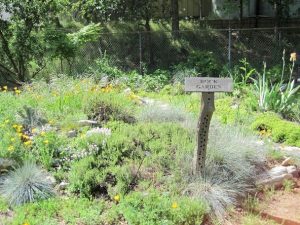If you’ve ever thought about replacing your lawn with something less thirsty (and less work), this is the year to do it. Because of the severity of the current drought, Tuolumne Utilities District currently has a total ban on watering lawns; so water-hungry grasses will likely die this year in our typically hot, dry summer.
So, what are the alternatives? You could replace the lawn entirely with some combination of hardscape and drought-tolerant ground covers (and there are many of the latter). But if you have your heart set on something resembling a lawn, something kids and pets can play on, consider buffalo grass.
Native to the American prairies (yes, where the buffalo roam), several varieties of this low-maintenance grass have been studied by universities, including UC Davis, for their usefulness in other parts of the country. There are a lot of reasons to choose buffalo grass for California landscapes:
Because of its deep root system (6- to 8-ft deep), buffalo grass requires about 1/4-inch of water per week, which is about 75 percent less than traditional lawns.
- Most varieties have a broad, natural insect and disease resistance.
- It requires little fertilizer and, compared to traditional lawns, infrequent mowing.
- The top-rated buffalo grasses for our area (see below) are nearly pollen free, so they are excellent choices for people with grass allergies.
The Tuolumne County Master Gardeners started experimenting in 2008 with buffalo grass in their demonstration garden near Casina High School, on Barretta Street in downtown Sonora. One variety, “Prestige,” has been a clear winner for appearance and hardiness in the demo garden, but the UC Davis-developed “UC Verde” comes in a close second. Prestige, released for commercial cultivation in 2004 by the University of Nebraska, produces a soft, dense grass of medium-green color with fine blades. In most locations, it grows four to six inches tall, spreads quickly, and is aggressive enough to choke out most weeds. Prestige is recommended for elevations above 1,200 feet and as high as 6,000 feet. UC Verde has the same qualities as Prestige but can reach a height of eight inches. It is recommended for elevations below 1,200 feet. Both varieties require full sun for at least six hours a day.
Both Prestige and UC Verde turn brown in winter, but reliably return to put on a show of green in spring. (If you cannot tolerate a brown lawn even in winter, you can actually buy a turf colorant to keep it looking vibrant.) You can create a buffalo grass lawn with seed, sod or plugs, the latter being the most popular method. Normally the best time to plant buffalo grass is from April 1 to October 1. But since even drought-tolerant grasses need a little more water when first planted to get established, this fall would be the best time to plant buffalo grass in the foothills.
To learn more about buffalo grass in general, and Prestige and UC Verde varieties in particular, visit these websites, from which you can order plugs:
www.toddvalleyfarms.com, is a Nebraska-based grower from whom the Tuolumne County Master Gardeners purchased Prestige. This website also offers a tool to calculate how many plugs you will need to cover the size of your new lawn.
www.florasourceltd.com, a firm based in San Clemente, California, is very informative and has great photos of UC Verde lawns.
www.ucverdebuffalograss.com, is the buffalo grass-specific website for another California-based grower, Takao Nursery in Fresno.
If you would like to see the small plots of buffalo grass in the Master Gardener Demonstration Garden, you can visit during Open Garden Day on the first Saturday of each month, from 10am to 1pm.


